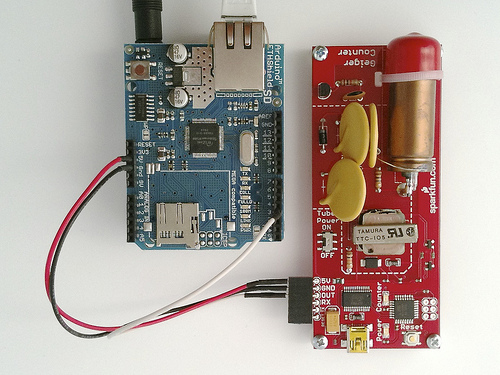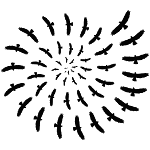
Map of March 22, 2011 by Pachube
Sensing Radiation
The recent events following the nuclear disaster in Japan have brought a variety of people together to participate in the relief efforts. One such group has tackled the problem of radiation which contaminates the air. This resulted in a crowd-sourced acquisition of radioactivity using DIY Geiger counters sensing radiation in Sieverts across Japan (over 200 locations) and aggregated in a map visualization.
An example of DIY Geiger counter was recently covered by sparkfun, a supplier in hardware, based on the design of a customer and open hardware enthusiast, Shigeru Kobayashi. It is based on the Sparkfun SEN-09848 which could be used, under different circumstances, as random number generator. The little Geiger tube mounted on the board contains a gas which can be have its atoms ionized when hit by a radioactive particle. This leads to an electron cascade inside the tube and eventually a detectable pulse for the event. The product is priced at USD 150 with the tube alone priced at approximately USD 90 at the time of writing. Since the sparkfun board comes with an USB, sensing could be done from computer. As a computer is a rather expensive and powerful resource, Shigeru also designed a standalone Arduino-controlled sensor. The role of the microcontroller is to capture data and post it to an Internet service for later retrieval. That service, called Pachube pronounced Patch Bay, is a broker platform for sensors. An Arduino board does not come with Ethernet capabilities. For that, an optional Ethernet shield is required. The resulting assembly is shown below. The Arduino board cannot be seen as it is directly below the Ethernet shield. The Geiger tube on the other hand can clearly be seen on the sparkfun board.

Photo by kogoro.kotobuki
Delivering data from sensors in real-time for applications such as a map visualization is not trivial. There are three aspects to take into consideration: Metrology, Syndication and Scalability. Metrology refers to the measurement itself – here radioactivity in events per minute, microsieverts per hour or nanogray per hour. Then there is the question of syndication or format supported for data submission and representation of the historical data for retrieval by different client applications. Finally, there’s scalability or the ability to support many thousands of sensors simultaneously. Open Sen.se is another broker service addressing these issues.
Shigeru and all other citizen scientists have currently opted for the Pachube platform which powers the map visualization provided above. More details on Shigeru’s implementation can be found online on yapan.org.
Citizen Science For Sustainability
Citizen scientists are traditionally known for their contributions to biodiversity tracking e.g. certain bird species, garden insects or the state of watersheds. Their result can be usually be seen in the form of maps which visualize the state of the system they monitor. This activity is essential for the protection of ecosystems and drains thousands of hours of spare time devoted by volunteers across the world. As I have written before, it is a good example of what Clay Shirky calls Cognitive Surplus. But citizen science activities are usually dissociated from catastrophic events. Yet the recent events in Japan show that when a tipping point is reached, the line between citizen science and crisis mapping is easily crossed.
Ushahidi, a classical crisis mapping platform and open source project I follow, had been quickly deployed on sinsai.info within hours of the Tsunami to assist with the needs of disaster relief around the Fukushima area. It collects a number of reports by people in the area which helps coordinate efforts on the ground. These reports are what I call soft sensing and could be well complemented by hard sensing such as the tracking of radioactivity values on the same platform.
Clay Shirky estimates cognitive surplus of people at a trillion hours per year. What if part of that time was dedicated to other topics in sustainability such as pollution, energy, waste in complement to the many biodiversity projects already undergoing? I am tracking some of these projects on a Google doc. They are still very few. Such projects could be designed in a way that when a tipping point is reached, citizen science switches gears and becomes an essential ingredient in crisis relief.
The beauty of the DIY and open approaches behind Pachube, Arduino or Ushahidi is that (1) they are easily accessible at low cost and (2) adaptable to the acquisition protocol required. Sustainability can hardly be framed by a few use cases but providing the tools to sense our environment and visualize the state of an ecosystem to policy makers seems like a good idea to pursue.
 This material is licensed under CC BY 4.0
This material is licensed under CC BY 4.0
